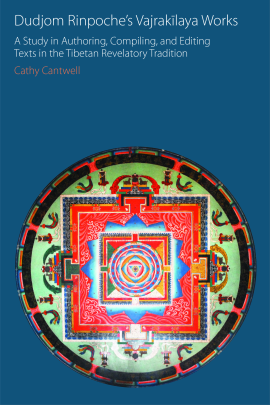
Dudjom Rinpoche's Vajrakīlaya Works
A Study in Authoring, Compiling and Editing Texts in the Tibetan Revelatory Tradition
It is often assumed that a revelation must be new and innovative, and indeed, that the point of a new sacred text must be to revitalize the heritage. Yet in the Tibetan Nyingma Treasure Revelatory tradition, the ongoing vitality of textual production often has more to do with the fresh blessings,... Read more
Published: 2020
Pages: 409
eBook: 9781781797617
It is often assumed that a revelation must be new and innovative, and indeed, that the point of a new sacred text must be to revitalize the heritage. Yet in the Tibetan Nyingma Treasure Revelatory tradition, the ongoing vitality of textual production often has more to do with the fresh blessings, rather than altogether novel content. This book for the first time analyses precise continuities and changes in comparing the new and the old, considering examples of the creation and development of tantric revelations, including further re-workings in subsequent generations. In doing so, the focus enlarges to encompass materials from the broader religious heritage, as well as from specific lineages of related visionary lamas. By identifying such exact linkages and departures, it is possible to answer questions both of how and why developments may occur, not limiting the purview merely to the individual stories of the virtuoso lamas producing the books, but looking also to the tantric communities they are part of. The case studies in the book stem from the prolific writings of the famous 20th century scholar-lama, Dudjom Jigdral Yeshe Dorje Rinpoche, who contributed to numerous revelatory traditions of the past, as well as producing his own revelations. They concern a single tantric deity, Vajrakīlaya, the most popular Nyingma deity, whose tantras and ritual practices stem from the earliest formulations of Tibetan tantric Buddhism, and who is closely connected with the culture heros and founding fathers of the Nyingmapa. This particular focus gives us the opportunity to discover patterns in the creation of new tantric texts which have significance beyond the specific examples.
"This is an extremely valuable and well-researched contribution to Tibetan studies. While the work is primarily aimed at readers engaged in Tibetan studies, it should be of interest to Tibetan traditional scholars and monastics of the young generation, as well as Western Buddhists who are not necessarily scholars, but are prepared to make an effort to learn from a work of scholarship." Professor Per KvAerne, Department of Culture Studies and Oriental Languages, University of Oslo
| Cover | Cover | ||
|---|---|---|---|
| Contents | v | ||
| List of figures | vii | ||
| Acknowledgements | ix | ||
| Note on representation of Tibetan in this book | xi | ||
| Introduction | 1 | ||
| 1 | 30 | ||
| 2 | 47 | ||
| 3 | 78 | ||
| 4 | 95 | ||
| 5 | 113 | ||
| 6 | 136 | ||
| 7 | 161 | ||
| 8 | 184 | ||
| 9 | 205 | ||
| 10 | 239 | ||
| 11 | 270 | ||
| 12 | 295 | ||
| 13 | 326 | ||
| 14 | 351 | ||
| Bibliography | 366 | ||
| Index | 387 |
